LG Electronics USA KP202 PCS GSM Phone User Manual KP202 UK 120613
LG Electronics USA PCS GSM Phone KP202 UK 120613
Users Manual

User Manual
KP202
Designed for
Vodafone live!
ENGLISH
www.lgmobile.com

KP202 USER GUIDE
ENGLISH
1. When this crossed-out wheeled bin symbol is attached to a product it means the
product is covered by the European Directive 2002/96/EC.
2. All electrical and electronic products should be disposed of separately from the
municipal waste stream via designated collection facilities appointed by the government
or the local authorities.
3. The correct disposal of your old appliance will help prevent potential negative
consequences for the environment and human health.
4. For more detailed information about disposal of your old appliance, please contact your
city office, waste disposal service or the shop where you purchased the product.
Disposal of your old appliance
This document is the user guide for the LG KP202 camera
Mobile Phone. All rights for this document are reserved by
LG Electronics. Copying, modifying and distributing this
document without the consent of
LG Electronics are prohibited.

Introduction
2
Introduction
Congratulations on your purchase of the advanced
and compact KP202 camera phone, designed to
operate with the latest digital mobile communication
technology.
This user’s guide contains important information on the use
and operation of this phone. Please read all the information
carefully for optimal performance and to prevent any
damage to or misuse of the phone. Any changes or
modifications not expressly approved in this user’s guide
could void your warranty for this equipment.

For Your Safety
3
For Your Safety
Please read these simple guidelines. Not following
these guidelines may be dangerous or illegal. Further
detailed information is given in this manual.
WARNING!
• Mobile Phones must be switched off at all times in aircrafts.
• Do not hold the phone in your hand while driving.
• Do not use your phone near petrol stations, fuel depots,
chemical plants or blasting operations.
• For your safety, use ONLY specified ORIGINAL batteries
and chargers.
• Do not handle the phone with wet hands while it is being
charged. It may cause an electric shock or seriously damage
your phone.
• Keep the phone in a safe place out of small children’s reach.
It includes small parts which, if detached, may cause a
choking hazard.
CAUTION!
• Switch off the phone in any area where required by special
regulations. For example, do not use your phone in hospitals
or it may affect sensitive medical equipment.
• Emergency calls may not be available under all mobile
networks. Therefore, you should never depend solely on your
mobile phone for emergency calls.
• Only use ORIGINAL accessories to avoid damage to your
phone.
• All radio transmitters carry risks of interference with
electronics in close proximity. Minor interference may affect
TVs, radios, PCs, etc.
• Batteries should be disposed of in accordance with relevant
legislation.
• Do not dismantle the phone or battery.


Guidelines for Safe and Efficient Use
8
Guidelines for Safe and Efficient Use
network. In some cases, transmission of data files
or messages may be delayed until such a
connection is available. Ensure the above
separation distance instructions are followed until
the transmission is completed. The highest SAR
value for this device when tested for use at the
body is {a.bc} W/kg.
* The SAR limit for mobile devices used by the public
is 2.0 watts/kilogram (W/kg) averaged over ten
grams of body tissue. The guidelines incorporate a
substantial margin of safety to give additional
protection for the public and to account for any
variations in measurements. SAR values may vary
depending on national reporting requirements and
the network band. For SAR information in other
regions please look under product information at
www.{terminal-manufacturer}.com.
The exposure standard for wireless mobile phones
employs a unit of measurement known as the Specific
Absorption Rate, or SAR. The SAR limit set by the
FCC is 1.6W/kg. * Tests for SAR are conducted using
standard operating positions specified by the FCC
with the phone transmitting at its highest certified
power level, the actual SAR level of the phone while
operating can be well below the maximum value. This
is because the phone is designed to operate at
multiple power levels so as to use only the power
required to reach the network. In general, the closer
you are to a wireless base station antenna, the lower
the power output.
Before a phone model is available for sale to the
public, it must be tested and certified to the FCC
that ist does not exceed the limit established by the
government-adopted requirement for safe exposure.
The tests are performed in positions and locations
(e.g., at the ear and worn on the body)as required by
the FCC for each model. The highest SAR value for
this model phone when tested for use at the ear is
0.467 W/kg and when worn on the body, as
described in this user guide, is 0.295W/kg, (Body-
worn measurements differ among phone models,
depending upon available accessories and FCC
requirements). [Labeling Committee note : if
applicable, if body-worn SARs are required]. While
there may be differences between the SAR levels of
various phones and at various positions, they all
meet the government requirement for safe exposure.

9
Guidelines for Safe and Efficient Use
The FCC has granted an Equipment Authorization for
this model phone with all reported SAR levels
evaluated as in compliance with the FCC RF emission
guidelines. SAR information on this model phone is
on file with the FCC and can be found under the
Display Gant section of http://www.fcc.gov/oet/fccid
after searching on FCC ID BEJKP202.
Product care and maintenance
]
Do not disassemble this unit. Take it to a qualified
service technician when repair work is required.
]
Keep away from electrical appliances such as a
TV's, radios or personal computers.
]
The unit should be kept away from heat sources
such as radiators or cookers.
]
Never place your phone in a microwave oven as it
will cause the battery to explode.
]
Do not drop.
]
Do not subject this unit to mechanical vibration or
shock.
]
The coating of the phone may be damaged if
covered with wrap or vinyl wrapper.
]
Do not use harsh chemicals (such as alcohol,
benzene, thinners, etc.) or detergents to clean
your phone. There is a risk of this causing a fire.
]
Do not subject this unit to excessive smoke or
dust.
]
Do not keep the phone next to credit cards or
transport tickets; it can affect the information on
the magnetic strips.
]
Do not tap the screen with a sharp object as it
may damage the phone.
]
Do not expose the phone to liquid or moisture.
]
Use accessories, such as earphones and headsets,
with caution. Ensure that cables are tucked away
safely and do not touch the antenna unnecessarily.
]
Please remove the data cable before powering on
the handset.
WARNING!
Only use batteries, chargers and accessories approved for use
with this particular phone model. The use of any other types
may invalidate any approval or warranty applying to the
phone, and may be dangerous.

Guidelines for Safe and Efficient Use
10
Guidelines for Safe and Efficient Use
Efficient phone operation
To enjoy optimum performance with minimum
power consumption please.
]
Do not hold the antenna when the phone is in use.
If you hold it, it can affect call quality, it may also
cause the phone to operate at a higher power level
than needed and shorten talk and standby times.
Electronic devices
All mobile phones may get interference, which
could affect performance.
]
Do not use your mobile phone near medical
equipment without requesting permission. Avoid
placing the phone over pacemakers. (i.e. in your
breast pocket.)
]
Some hearing aids might be disturbed by mobile
phones.
]
Minor interference may affect TVs, radios, PCs, etc.
Road safety
Check the laws and regulations on the use of
mobile phones in the areas when you drive.
]
Do not use a hand-held phone while driving.
]
Give full attention to driving.
]
Use a hands-free kit, if available.
]
Pull off the road and park before making or
answering a call if driving conditions so require.
]
RF energy may affect some electronic systems in
your motor vehicle such as a car stereo or safety
equipment.
]
If your vehicle is equipped with an air bag, do not
obstruct it with installed or portable wireless
equipment. It can cause serious injury due to
improper performance.
If you are listening to music whilst outside and
about, please ensure that the volume is at a
reasonable level so that you are aware of your
surroundings.
This is particularly imperative when attempting to
cross the street.

11
Guidelines for Safe and Efficient Use
Avoid damage to your hearing
]
Damage to your hearing can occur if you are
exposed to loud sound for long periods of time.
We therefore recommend that you do not turn the
handset on or off close to your ear. We also
recommend that music and call volumes are set to
a reasonable level.
]
If you are listening to music whilst out and about,
please ensure that the volume is at a reasonable
level so that you are aware of your surroundings.
This is particularly imperative when attempting to
cross the street.
Blasting area
Do not use the phone where blasting is in progress.
Observe restrictions, and follow any rules or
regulations.
Potentially explosive atmospheres
]
Do not use the phone at a refueling point. Don't
use near fuel or chemicals.
]
Do not transport or store flammable gas, liquid, or
explosives in the compartment of your vehicle,
which contains your mobile phone and accessories.
In aircraft
Wireless devices can cause interference in aircraft.
]
Turn off your mobile phone before boarding any
aircraft.
]
Do not use it on the ground without crew
permission.
Children
Keep the phone in a safe place out of small children's
reach. It includes small parts which if detached may
cause a choking hazard.
Emergency calls
Emergency calls may not be available under all mobile
networks. Therefore, you should never depend solely
on your mobile phone for emergency calls. Check
with your local service provider.

Guidelines for Safe and Efficient Use
12
Guidelines for Safe and Efficient Use
Battery information and care
]
You do not need to completely discharge the
battery before recharging. Unlike other battery
systems, there is no memory effect that could
compromise the battery's performance.
]
Use only LG batteries and chargers. LG chargers
are designed to maximize the battery life.
]
Do not disassemble or short-circuit the battery
pack.
]
Keep the metal contacts of the battery pack clean.
]
Replace the battery when it no longer provides
acceptable performance. The battery pack may be
recharged hundreds of times until it needs
replacing.
]
Recharge the battery if it has not been used for a
long time to maximize usability.
]
Do not expose the battery charger to direct
sunlight or use it in high humidity, such as the
bathroom.
]
Do not leave the battery in hot or cold places, this
may deteriorate the battery performance.

11
For Your Safety
Vehicle Mounted External Antenna
(optional, if available)
A minimum separation distance of 8 inches (20cm) must be
maintained between the user/bystander and the vehicle
mounted external antenna to satisfy FCC RF exposure
requirements. For more information about RF exposure, visit
the FCC website at www.fcc.gov
FCC Part 15 Class B Compliance
This device and its accessories comply with part 15 of FCC
rules. Operation is subject to the following two conditions:
(1) This device and its accessories may not cause harmful
interference, and (2) this device and its accessories must
accept any interference received, including interference that
may cause undesired operation.
Cautions for Battery
]Do not disassemble.
]Do not short-circuit.
]Do not expose to high temperature: 60°C (140°F).]
]Do not incinerate.
Battery Disposal
]Please dispose of your battery properly or bring to your
local wireless carrier for recycling.
]Do not dispose in fire or with hazardous or flammable
materials.
Adapter (Charger) Cautions
]Using the wrong battery charger could damage your phone
and void your warranty.
]The adapter or battery charger is intended for indoor use
only.
Do not expose the adapter or battery charger to direct sunlight
or use it in places with high humidity, such as the bathroom.
Part 15.21 statement
" Change or Modifications that are not expressly approved by the manufacturer could void
the user's authority to operate the equipment. "
Part 15.105 statement
This equipment has been tested and found to comply with the limits for a class B digital device,
pursuant to Part 15 of the FCC Rules.
These limits are designed to provide reasonable protection against harmful interference in a
residential installation.
This equipment generates uses and can radiate radio frequency energy and, if not installed and used
in accordance with the instructions, may cause harmful interference to radio communications.
However, there is no guarantee that interference will not occur in a particular installation. if this
equipment does cause harmful interference or television reception, which can be determined by
turning the equipment off and on, the user is encouraged to try to correct the interference by one or
more of the following measures:
- Reorient or relocate the receiving antenna.
- Increase the separation between the equipment and receiver.
- Connect the equipment into an outlet on a circuit different from that to
which the receiver is connected
- Consult the dealer or an experienced radio/TV technician for help.

Getting Started
9
Getting Started
Installing the USIM card
and battery
1. Installing the USIM card.
Your USIM card contains your phone number,
service details and contacts and must be inserted
into your handset.
If your USIM card is removed then your handset
becomes unusable (except for emergency calls) until
a valid one is inserted. Always disconnect the charger
and other accessories from your handset before
inserting and removing your USIM card. Slide the
USIM card into the USIM card holder.
Make sure that the USIM card is properly inserted
and the gold contact area on the card is facing
downwards. To remove the USIM card, press down
lightly and pull it in the reverse direction.
Note
]
The metal contact of the USIM card can easily be
damaged by scratches. Pay special attention to the
USIM card while handling. Follow the instructions
supplied with the USIM card.

Getting Started
10
Getting Started
2. Installing the battery.
Insert the battery aligning the gold contacts on the
battery with the battery terminals (gold contacts) in
the battery compartment. Then push down the top
of the battery until it snaps into place.
To remove the battery.
Turn the power off. (If the power is left on, there is a
chance you could lose the stored telephone numbers
and messages.) Press the battery release latches
and open the battery . Then remove the battery.

11
Getting Started
Charging the Battery
Before connecting the travel adapter to the phone
you must first install the battery.
1. With the arrow facing you as shown in the diagram
push the plug on the battery adapter into the
socket on the left side of the phone until it clicks
into place.
2. Connect the other end of the travel adapter to
the mains socket.
3. The moving bars on the battery icon will stop
after charging is complete.
4. Ensure the battery is fully charged before using
the phone for the first time.
Disconnecting the charger
Disconnect the travel adapter from the phone
as shown in the diagram below.
Note
]
Only use the charger included in the box
.
WARNING!
• Unplug the power cord and charger during lightning storms
to avoid electric shock or fire.
• Make sure that no sharp-edged items such as animal teeth
or nails, come into contact with the battery.
This may cause a fire.
• Do not place or answer calls while charging the phone
as it may short-circuit the phone and/or cause electric
shock or fire.
CAUTION!
• Do not force the connector as this may damage the phone
and/or the travel adapter.
• If you use the battery pack charger when abroad, use an
attachment plug adaptor for the proper configuration.
• Do not remove your battery or the USIM card while
charging.

Getting Started
12
Getting Started
Attention:
]
Avoid using the Flash Memory Card when the
battery is low.
]
When writing to the card, wait for the operation to
complete before removing the card.
]
The card is designed to fit easily into the system
one way only.
]
Do not bend the card or force it into the slot.
]
Do not insert any memory cards other than those
made by microSD.
]
If the microSD has been formatted using FAT32,
format the microSD using FAT16 again.
For more information on the microSD, please refer to
the memory card instruction manual.
Memory card formatting
Before you start to use the memory card you have to
format it. After you insert the memory card, select
Menu > Settings > Phone settings > Memory status
> Format external memory, then press .
This operation should only be done when you insert
the memory card for the first time.
During formatting various folders will be created for
different data types.
Turning the handset on/off
Turning your handset on
Ensure that your USIM card is in your handset and
the battery is charged. Press and hold until the
power comes on. Enter the USIM PIN code that was
supplied with your USIM card if the PIN code
request is set to On. (Note: Please refer to page 71)
After a few seconds you will be registered on the
network.
Turning your handset off
Press and hold until the power goes off.
There may be a few seconds delay while the handset
powers down.
Do not turn the handset on again during this time.

13
Getting Started
Access codes
You can use the access codes described in this
section to avoid unauthorised use of your phone.
The access codes (except the PUK and PUK2 codes)
can be changed by using the Change codes feature
[Menu #.1.4.3].
PIN code (4 to 8 digits)
The PIN (Personal Identification Number) code
protects your USIM card against unauthorised use.
The PIN code is usually supplied with the USIM card.
When the PIN Code Request is set to On, your
phone will request the PIN code every time it is
switched on. When the PIN Code Request is set to
Off, your phone connects to the network directly
without the PIN code.
PIN2 code (4 to 8 digits)
The PIN2 code, supplied with some USIM cards, is
required to access functions such as Fixed Dial
Number. These functions are only available if
supported by your USIM card.
PUK code (4 to 8 digits)
The PUK (PIN Unblocking Key) code is required to
unblock a blocked PIN code. The PUK code may be
supplied with the USIM card. If not, contact your
network operator’s customer service department for
the code. If you lose the code, contact your network
operator’s customer service department.
PUK2 code (4 to 8 digits)
The PUK2 code, supplied with some USIM cards, is
required to unblock a blocked PIN2 code. If you lose
the code, contact your network operator’s customer
service department.
Security code (4 to 8 digits)
The security code prevents unauthorised use of
your phone. The default security code is set to
‘0000’ and the security code is required to delete all
phone entries and to restore the handset to the
factory settings.

Getting Started
14
Getting Started
Display information
No USIM idle screen
This is the initial screen of the phone that appears
when there is no USIM card installed in the phone,
or the installed USIM card is invalid. In this screen,
users can only make emergency calls, and turn the
phone off. To turn the phone off, press and hold
for a few seconds.
Screen structure
If there is no USIM card installed, an animation telling you
to insert a USIM card appears. If the USIM card inserted
into the phone is invalid, an animation telling you that the
USIM card is locked appears.
Emergency call function
The right soft key is represented by “Emergency”
on the screen. Press the right soft key or dial your
emergency number using the number keys,
and then press to make an emergency call.
Idle screen
The idle screen appears when you have installed
a proper USIM card and turned the phone on.
Screen structure
Idle screen consists of the operator's name,
indicators, date and time on a background image. You
can change the wallpaper in the Display settings
menu.
Numbering screen
The numbering screen appears when a number key is
pressed in the idle screen.
Screen structure
The numbering screen consists of status indicators,
dialled number and soft menu. Status indicators are
the same as those of the idle screen. You can change
the size and colour of the dialling font in the Display
settings menu. You can make a call while dialling a
phone number by pressing .

15
Getting Started
Soft key
You can use the soft keys for several functions while
dialling a number. Using the left soft key, you can
make a video call, send a message to the number,
save the number to Contacts.
Handset lock screen
When the Handset lock function is selected, you can
only make an emergency call, release the lock, and
turn off the phone in this screen. As always, you can
turn the phone off by pressing and holding
for a few seconds.
Screen structure
The screen structure of the Handset Lock screen is
the same as that of the idle screen, except that the
lock message appears instead of the idle screen.
Emergency call function
You can make an emergency call using the right soft
key. As with the No USIM idle screen, only
emergency numbers can be dialled.
Unlock function
If you press , a popup screen appears asking you
to input the Security code to unlock the phone.
The Security code is configured in the Change
codes (#. Settings > 1. Phone settings > 4. Security >
3. Change codes). If you key in an incorrect Security
Code, the phone will remain in Handset lock status.
If you key in the correct Security code, the phone will
be unlocked, and the idle screen will be displayed.
If you have turned the phone off in the Handset lock
status, you will find the phone remains in Handset
lock status when you turn it on.
Barring password
This service obstructs calling service in some
conditions. This condition can be edited using the
Call barring feature (#. Settings > 5. Call settings >
2. Call barring). The barring password is required
when you use the call barring function. The password
is obtained from your network operator's customer
service when you subscribe to this service.
While this service is activated, the caller will hear
the information message that the call is not
connected because of the call barring.
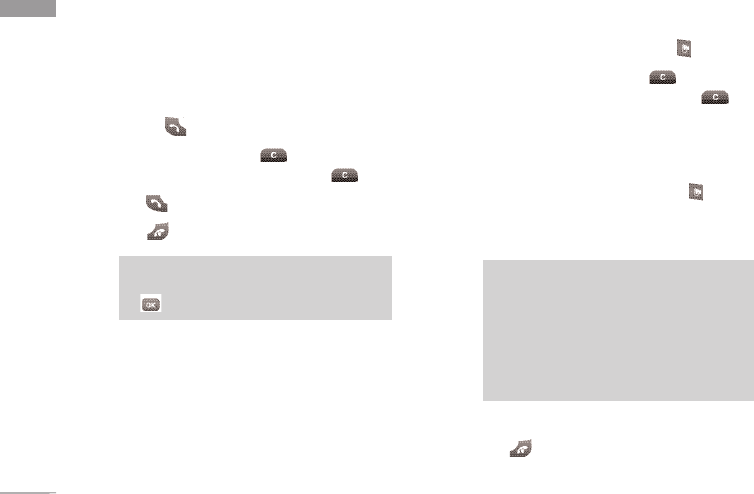
General Functions
16
General Functions
Making and answering calls
Making a voice call
1. Enter the number including the full area code,
or select the phone number from call logs by
pressing .
]
To delete a digit press .
To delete all digits press and hold .
2. Press to make the call.
3. Press to finish the call, or close the handset.
Making a video call
You can make a video call in a 3G covered service
area. If the called user has a 3G video phone in a 3G
covered service area, the call will be established.
You can also answer a video call for video incoming
call. To make/answer a video call, do the following.
1. Input the phone number using the keypad,
or select the phone number from the calls
made/received lists by pressing .
]
To correct mistakes, press briefly to delete
the last number, or press and hold to delete
all numbers.
2. If you do not want to use the speakerphone,
ensure you have the headset plugged in.
3. To start the video function, press .
]
You will be notified that you will need to close
other applications to Make video call.
4. Adjust the camera position if necessary.
5. Press to finish the call, or close the handset.
Note
]
The video call may take some time to connect.
Please be patient. The connection time will also
depend on how quickly the other party answers
the call. While the video call is connecting, you
will see your own image; after the other party
has answered, their image will be displayed on
the screen.
Note
]
To activate the speakerphone during a call, press
.

17
General Functions
Making a voice/video call from Contacts
It is easy to call anyone whose number you have
stored in your Contacts.
1. Press to access the contacts list.
2. Scroll to the contact to make a call.
3. Press to make a voice call.
Press to make a video call. Or press the left
soft key and select Make video call.
4. Press to finish the call.
Making international calls
1. Press and hold for the international prefix.
The ‘+’ character prefixes the international access
code.
2. Enter the country code, area code, and the phone
number.
3. Press .
Adjusting the volume
During a call, if you want to adjust the earpiece
volume, use on the left side of the handset.
In idle mode with the phone open, you can adjust
the key volume using .
Answering a call
When you receive a call, the phone rings and the
flashing phone icon appears on the screen. If the
caller can be identified, the caller’s phone number
(or name if stored in your Contacts) is displayed.
1. Open the phone and press to answer an
incoming call. If the answer mode is set to Press
any key, any key will answer a call except for .
Note
]
To reject an incoming call, press or the right soft key
twice.
]
If you set Answer mode as Open flip (Menu #.5.0.4),
you can answer the call simply by opening the phone.
2. End the call by closing the handset or pressing .
Note
]
You can answer a call while using Contacts or other menu
features.
]
When the compatible headset is connected, you can also
answer a call using the headset key, as well as using the
phone. To reject an incoming call, press .
]
You can mute the ringtone when a call comes in by pressing
and holding the volume down side key.

General Functions
18
General Functions
Shortcut to activate silent mode
You can activate the silent mode by pressing and
holding down after opening the phone.
Signal strength
You can check the strength of your signal by the
signal indicator ( ) on the LCD screen of your
phone. Signal strength can vary, particularly inside
buildings. Moving close to a window may improve
reception.
Entering text
You can enter alphanumeric characters using the
keypad.
For example, storing names in Contacts, writing a
message, creating a personal greeting or scheduling
events in the calendar all require entering text.
The following text input methods are available with
the handset.
T9 mode
This mode lets you enter words with only one
keystroke per letter. Each key on the keypad has
more than one letter. The T9 mode automatically
compares your keystrokes with an internal
dictionary to determine the correct word,
thus requiring far fewer keystrokes than the
traditional ABC mode. This is sometimes known
as predictive text.
ABC mode
This mode lets you enter letters by pressing the
key labelled with the required letter once, twice,
three or four times until the letter is displayed.
123 mode (Number mode)
Type numbers using one keystroke per number.
To change to 123 mode in a text entry field, press
until 123 mode is displayed.

19
General Functions
Changing the text input mode
1. When you are in a field that allows characters to
be entered, you will notice the text input mode
indicator in the upper right corner of the LCD
screen.
2. Press to switch between T9Abc, T9abc, Abc,
abc and 123.
Using the T9 Mode
The T9 predictive text input mode allows you to
enter words easily with a minimum number of key
presses. As you press each key, the handset begins
to display the characters that it thinks you are typing
based on a built-in dictionary. As new letters are
added, the word changes to reflect the most likely
candidate from the dictionary.
1. When you are in the T9 predictive text input
mode, start entering a word by pressing keys
to . Press one key per letter.
]
The word changes as letters are typed.
Ignore what’s on the screen until the word is
typed completely.
]
If the word is still incorrect after typing
completely, press once or more to scroll
through the other word options.
Example
Press to type Good.
Press to get Home.
]
If the desired word is missing from the word
choices list, add it by using the ABC mode.
2. Enter the whole word before editing or deleting
any keystrokes.
3. Complete each word with a space by pressing
.
To delete letters, press . Press and hold down
to erase entire words.
Using the ABC Mode
Use to to enter your text.
1. Press the key labelled with the required letter:
]
Once for the first letter.
]
Twice for the second letter.
]
And so on.
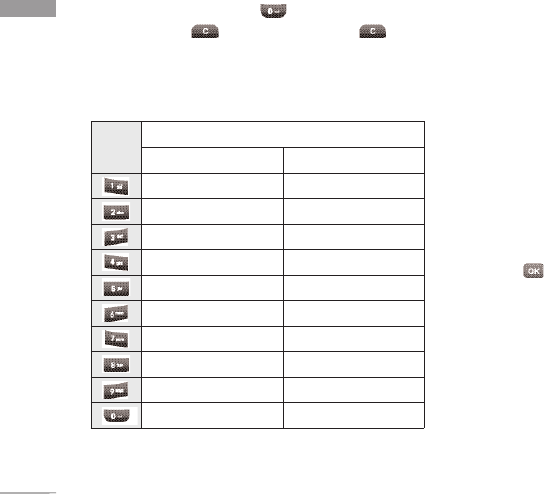
General Functions
20
General Functions
2. To insert a space, press once. To delete
letters, press . Press and hold down to
clear the display.
Refer to the following table for more information on
the characters available using the alphanumeric keys.
Note
]
The characters assigned to the keys and their order of
appearance depends on the language selected using the
option Input method. The table above provides the
characters set for English language.
Using the 123 (Number) mode
The 123 mode enables you to enter numbers in a
text message (a telephone number, for example).
Press the keys corresponding to the required digits
before manually switching back to the appropriate
text entry mode.
Using the symbol mode
The symbol mode enables you to enter various
symbols or special characters. To enter a symbol,
Options > Insert > Symbol. Use the navigation
and numeric keys to select the desired symbol
and press .
Lower CaseUpper Case
. , / ? ! - : ' " 1. , / ? ! - : ' " 1
a b c 2AB C 2
d e f 3D E F 3
g h i 4G H I 4
j k l 5J K L 5
m n o 6
M N O 6
p q r s 7P Q R S 7
t u v 8T U V 8
w x y z 9W X Y Z 9
Space 0Space 0
Characters in the order display
Key
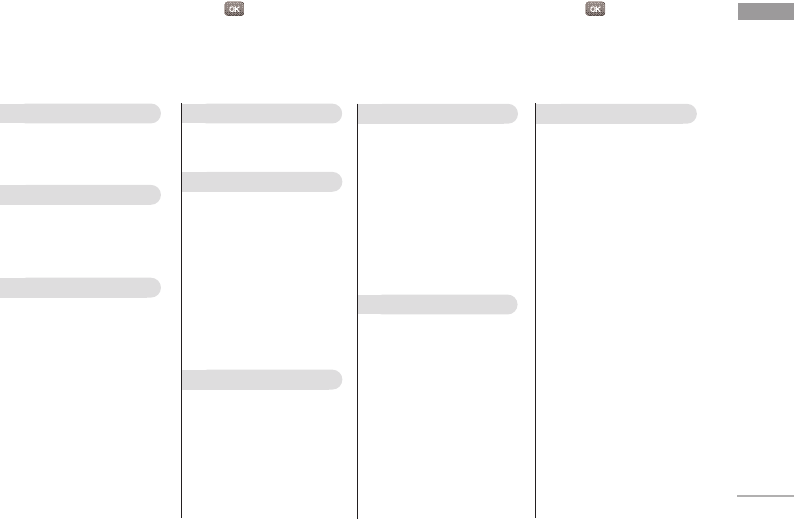
Overview of Menu Functions
21
Overview of Menu Functions
You can launch a menu by pressing in the idle screen. Move to the desired item and press to go into the
sub menu.
From the main menu you can also go into a submenu by directly pressing the corresponding numeric key
as follows. The main menu consists of the following top menus and sub menus.
1.1 Games & Applications
1. Games & Applications
2.1 Internet
2. Browser
3.1 All calls
3.2 Missed calls
3.3 Dialled calls
3.4 Received calls
3. Call history
4.1 Camera
4.2 Video recorder
4. Multimedia
5.1 Write text message
5.2 Write multimedia
message
5.3 Inbox
5.4 Drafts
5.5 Outbox
5.6 Listen to voice mail
5.7 Info message
5.8 Templates
5.9 Settings
5. Messages
6.1 Games & Applications
6.2 Images
6.3 Sounds
6.4 Others
6. My Files
7.1 LG Electronics
7.2 Alarm clock
7.3 Calendar
7.4 Tasks
7.5 Memo
7.6 Calculator
7.7 Unit converter
7.8 World time
7.9 Stopwatch
7. Fun & Tools
8.1 New contact
8.2 Contacts list
8.3 Speed dials
8.4 Groups
8.5 Copy all
8.6 Delete all
8.7 Contacts settings
8.8 Information
8. Contacts
9.1 Phone settings
9.2 Profiles
9.3 Display
9.4 Call settings
9.5 Network settings
9.6 Reset
9.7 Memory status
9. Settings
* : Shown only if supported by the service provider

Games & Applications
22
Games & Applications
Games & Applications Menu 1.1
You can easily download games and other
applications in this menu. It has two folders, Games
and Applications, as default. Each folder has an
embedded link for downloading games or
applications. Please note that additional costs may
be incurred when using online services. You can
create a folder using the left soft key [Options].

Browser
23
Browser
Internet Menu 2.1
You can launch the web browser and access the
homepage of the web service provided by Vodafone.
]
You can also directly access Vodafone live! by
pressing the right soft key in idle mode.

Call history
24
Call history
You can check the record of missed, received, and
dialled calls only if the network supports Calling Line
Identification (CLI) within the service area.
The number and name (if available) are displayed
together with the date and time at which the call was
made. You can also view call times.
All calls Menu 3.1
Allows you to view the missed, received, and dialled
call records. You can make a call or send a message
to the number you have selected from the records.
You can also save the number in the Contacts.
Missed calls Menu 3.2
Allows you to view missed call records, make a call,
send a message and save the number in Contacts.
Dialled calls Menu 3.3
Allows you to view dialled call records, make a call,
send a message and save the number in Contacts.
Received calls Menu 3.4
Allows you to view received call records, make a call,
send a message and save the number in Contacts.
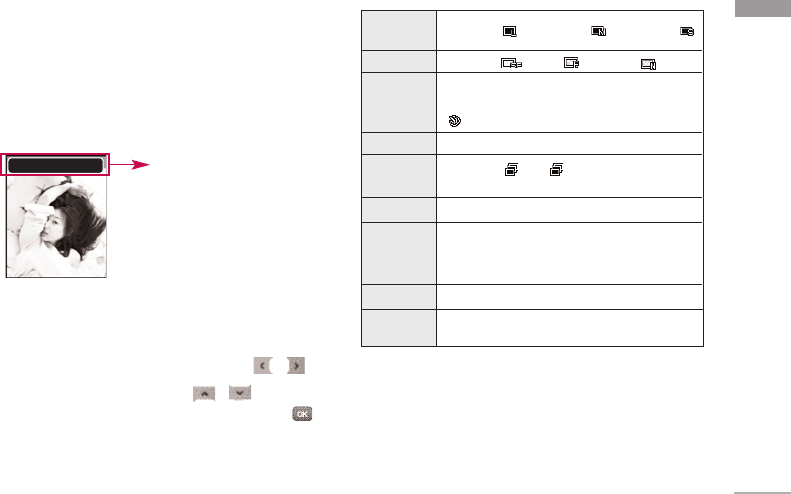
Multimedia
25
Multimedia
Camera Menu 3.1
Press the Menu key and select
Camera
using the
navigation keys. Or you can directly open the camera
module by a press of the Camera key in standby
mode. The camera module opens and you’ll see the
view to be captured.
1. Press the left soft key to access Menu and set the
desired environment as follows.
]
Move between the options menus with / .
]
Select the desired value with / and confirm
the selection with the left soft key [Select] or .
MMeennuu AAllbbuumm
preview option
menu bar
Resolution
640x480 ( ), 320x240 ( ), 160x120 ( )
Super fine ( ), Fine ( ), Normal ( )
You can delay the camera shutter time.
3 seconds
,
5 seconds
,
10 seconds
“ ” is shown when the timer is activated.
You can view Full image or Full screen.
One, Three( ), Six ( ) (Note: Available
multishot depends on the size.)
off, Sepia, Mono, Negative
You can adjust the tone of the background
photo according to the weather.
Auto, Daylight
Select the desired shutter sound.
Select the reset setting or not
Quality
Timer
View mode
Multishot
Effect
White
balance
Sutter tone
Reset
setting
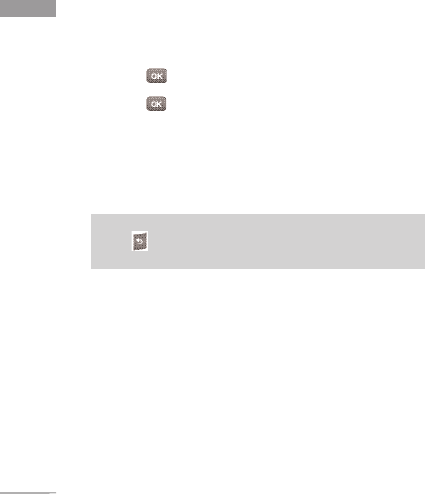
2. After finishing all the settings, press the right soft
key [Close].
3. Focus the camera on what you want to take and
press .
4. Press to save the picture. It is saved in the
Pictures folder of My Files.
You can directly send the picture via Message,
Postcard, Email or Bluetooth by pressing
the right soft key [Send].
Voice recorder Menu 3.2
In this feature you can record up to 10 voice memos,
up to a maximum of 20 seconds each.
Note
Press to go back to the preview mode without saving the
picture.
Multimedia
26
Multimedia

Messages
27
Write text message Menu 5.1
You can write and edit text messages up to 10 pages.
1. Enter the
Messages
menu by pressing [OK].
2. If you want to write a new message, select
Write
text message.
3. To make text input easier, use T9. For details, refer
to page 21 through 24 (Entering text).
4. Press [Insert] to attach the following ;
Insert
]
Symbol:
You can add special characters.
]
Text templates:
You can use Text templates already
set in the phone.
]
Contacts:
You can add phone numbers or e-mail
addresses in the address book.
]
My Business card:
You can add your business card
to the message.
5. After you have completed the message, to select
the required option, press the left soft key
[Options].
Options
]
Send to:
Sends the text message.
1. Enter the number of the recipient.
2. Press key to add more recipients.
3. You can add phone numbers from the address
book.
4. Once the numbers have been entered, press the
left soft key to send the message.
All messages will automatically be saved in the
outbox folder, even after a sending failure.
]
Save to drafts:
Stores messages in the Drafts
folder.
]
T9 languages:
Select the desired language for T9
input mode. You can also deactivate the T9 input
mode by selecting ‘T9 off’.
]
New T9 word:
You can add your own words. This
menu will only be shown when the edit mode has
been set to T9ABC/T9Abc/T9abc.
]
Clear text
Messages

Messages
28
Messages
]
Exit:
If you press Exit whilst writing a message, you
will be taken back to the message menu. Also the
written message will not have been saved.
Note
]
This phone supports EMS release 5, so is available to
send colour pictures, sounds, text styles, etc.. If the
other parties handsets do not support such options, the
pictures, sounds or texts sent may not be displayed
correctly on their phones.
Write multimedia message Menu 5.2
Inbox Menu 5.3
You will be alerted when you have received messages.
They will be stored in the Inbox.
In the Inbox, you can identify each message by their
icons. For detail, see the icon directive.
]Icon directive
If the phone shows ‘No space for SIM message’, you
only have to delete the SIM messages from the Inbox.
If the phone displays ‘No space for message’, you will
then need to delete messages, media or applications
to free up space.
Note
]
SSIIMM mmeessssaaggee::SIM message means the message is
exceptionally stored in the SIM card.
When you are notified that you have received a
multimedia message, you have to wait for the
message to be downloaded before you can view it.
For notification setting, see (Menu 4.8.2) for detail.
Icon Description
Multimedia message
Short message
SIM message
Read Short message
Read Multimedia message
Read
Notified multimedia message

29
Messages
To read a message, select one of the messages by
pressing .
]
View:
You can view the selected message.
]
Reply:
You can reply to the sender.
]
Forward:
You can forward the selected message to
another party.
]
Return call:
You can call the sender back.
]
Delete:
You can delete the current message.
]
Delete all:
Cancels all the message transmission
and deletes all of them.
]
Information:
You can view information about
received messages; Sender's address, Subject (only
for Multimedia message), Message date & time,
Message type, Message size.
]
Replay (applicable to Multimedia message only):
You can replay multimedia messages.
]
Receive (In the case of notification message):
If Multimedia message is set to Auto download off,
you can get only Notification. To receive a
message, you need to select [Receive].
Drafts Menu 5.4
You can view the messages saved as a draft. The draft
messages are listed with the date and time when they
were saved. Scroll through the list using up/down
navigation keys.
Each draft has the following options. Press
[Options].
]
View:
You can view the selected message.
]
Edit:
You can edit the selected message.
]
Delete:
Deletes the selected message from the
drafts folder.
]
Information:
You can view the information of
selected message: subject (only for multimedia
message), the date and time when saved, message
type and size, the priority (only for multimedia
message).
Icon Description
Multimedia message
Text message

Messages
30
Messages
]
Delete all:
Deletes all the messages from drafts
folder.
Outbox Menu 5.5
You can view the list and contents of sent messages
in this menu and can also verify if the transmission
was successful.
In each message, the following options are available
by pressing the left soft key [Options].
The messages of which transmission was
completed has the following options.
]
View:
You can view the selected message.
]
Forward:
You can forward the selected message to
other recipients.
]
Delete:
Deletes the selected message from outbox.
]
Information:
You can view the information of
selected message: subject (only for multimedia
message), the date and time when you sent it,
message type and size, the priority (only for
multimedia message), and recipients.
]
Delete all:
Deletes all the messages in the outbox
folder.
The messages of which transmission is in
progress has the following options.
]
View:
You can view the selected message.
]
Send:
Select this to send it again.
]
Cancel:
Cancels transmitting of the message.
]
Delete:
Cancels transmitting the message and
deletes the message.
]
Information:
You can view the information of
selected message: subject (only for multimedia
message), the date and time when you sent it,
message type and size, the priority (only for
multimedia message), and recipients.
MMS sent
MMS unsent
MMS delivery confirmed
SMS sent
SMS unsent
SMS delivery report
DescriptionIcon

31
Messages
]
Delete all:
Cancels all the message transmission
and deletes all of them.
Listen to voice mail Menu 5.6
This menu provides you with a quick way of accessing
your voice mailbox (if provided by your network).
Before using this feature, you must enter the voice
mail number obtained from your network operator.
When a new voice message is received, the
symbol will be displayed on the screen. A long press
of the key will take you directly into your
voicemail. Please check with your service operator for
details of their service in order to configure the
handset correctly.
Info message Menu 5.7
Shows the messages you sent (Message/ Postcard/
Email).
[Options]
]
View: Opens the selected message.
]
Reply: Creates a reply to sender or all recipients of
the selected message.
]
Forward: Forwards the selected message.
]
Delete: Deletes the current message.
]
Edit: You can edit the selected message.
]
Create new message: You can write a new
message.
]
Save number: Save the sender's number.
]
Mark/Unmark: You can select one or more
messages for multiple deletion.
]
Filter: Displays messages by desired message
types.
]
Copy: In case of SMS, you can copy the message
into handset or USIM.
]
Move: In case of SMS, you can move the message
into handset or USIM.
]
Message info.: You can check the message type,
date and time and where it is saved.

Messages
32
Messages
Templates Menu 5.8
Text templates (Menu 5.8.1)
You can add, edit, and delete frequently used useful
phrases using the left soft key [Options].
The followings are pre-defined text templates.
• Please call me back.
• I’m late. I will be there at
• Where are you now?
• I’m on the way.
• Top urgent. Please contact.
• I love you.
The following options are available.
]
View:
Select this to view the selected template.
]
Edit:
Use this to edit the selected template.
]
Write messages
-
Write text message:
Use this to send the
selected template message by SMS.
-
Write multimedia message:
Use this to send the
selected template message by MMS.
]
Add new:
Use this to create a new template.
]
Delete:
Deletes the selected template from the
text template list.
]
Delete all:
Deletes all templates.
Signature (Menu 5.8.2)
1. Press the left soft key [Edit].
2. After keying in the name, press the left soft key
[OK].
3. Key in the mobile phone number, home number,
office number and fax number.
4. Press the left soft key [Save].
After creating the business card template, you can
access the following menus by pressing the left soft
key [Options].
Note
Depending on your service provider, useful phrases are saved
as a default.

33
Messages
]
Edit:
Use this to edit the business card.
]
Send via:
You can send your business card via
Multimedia messge.
]
Delete:
Use this to delete the signature.
Settings Menu 5.9
Text message (Menu 5.9.1)
]
Message types:
Text, Voice, Fax, Natl. paging, X.400, Email,
ERMES
Usually, the type of message is set to Text. You can
convert your text into alternative formats. Contact
your service provider for the availability of this
function.
]
Validity period:
This network service allows you to
set how long your text messages will be stored at
the message centre.
]
Delivery report:
If you set to Yes, you can check
whether your message is sent successfully.
]
Reply charging:
When a message is sent, it allows
the recipients to reply and charge the cost of the
reply to your telephone bill.
]
SMS centre:
Saves or changes the number of your
SMS centre when sending text messages. You must
obtain this number from your service provider.
Voice mail centre (Menu 5.9.2)
You can receive voicemail if this feature is supported
by your network service provider. When a new
voicemail has arrived, the symbol will be displayed on
the screen. Please check with your network service
provider for details of their service in order to
configure the phone accordingly.
1. Hold down key in standby mode.
2. You can check the following submenus.
]
Home:
You can listen to voice mails by selecting
Home.
]
Roaming:
Even when you are abroad, you can
listen to voice mails if a roaming service is
supported.

Messages
34
Messages
Info message (Menu 5.9.3)
]
Receive
-
Yes:
If you select this menu, your phone will
receive Info service messages.
-
No:
If you select this menu, your phone will not
receive Info service messages any more.
]
Alert
-
Yes :
Your phone will beep when you have received
Info service message numbers.
-
No:
Your phone will not beep even though you
have received info service messages.
]
Languages
- You can select the language you want by pressing
[On/Off]. Then, the info service message will be
shown in the language that you have selected.
Push message (Menu 5.9.4)
You can set the option whether you will receive the
message or not.
How to access t-zones.
You can use your phone for so much more than just
texting and talking. t-zones provides information such
as news, weather forecast, information on sports or
traffic whenever you need it. In addition, t-zones
provides superior multimedia services such as the
latest music or ring tones, wallpapers or games for
your entertainment and device personalisation.
Press Menu from idle mode and select t-zones using
navigation keys. You can also access directly by
pressing the t-zones key in idle mode.
Note
]
Additional cost may occur when using online services.
Please contact your network operator/ service provider
for more details.

My Files
35
My Files
Games & Applications Menu 6.1
You can easily download games and other
applications in this menu. It has two folders, Games
and Applications, as default. Each folder has an
embedded link for downloading games or
applications. Please note that additional cost may be
incurred when using online services. You can create a
folder using the left soft key [Options].
Images Menu 6.2
The Pictures folder consists of embedded links
for downloading pictures through the Internet and
Default images.
Pictures taken using the camera are stored in the
Pictures folder and you can create new folders to
manage them. You can also save selected files as
animated Gifs and send multiple files to other people.
When a file is selected, the following options will be
displayed by pressing the left soft key [Options].
]
Connect: You can connect the Internet.
]
New folder: You can create a new folder within the
folder currently selected.
]
Delete more:
- Multi delete: Deletes the selected image.
- Delete all: Deletes all images.
]
Sort by: You can sort the files by date,type or
name.
]
View style: You can view the images as a
Thumbnail view or List view.
Sounds Menu 6.3
The Sounds folder consists of embedded links for
downloading ringtones and music as well as folders
containing the Default sounds and Voice recordings.
Here you can manage, send or set sounds as
ringtones.
Others Menu 6.4
Other files except pictures, sounds, videos, games &
applications are stored in this folder.

Fun & Tools
36
Fun & Tools
LG Electronics Menu 7.1
Alarm clock Menu 7.2
If you set the alarm, the appears on the indicator
bar. The specified alarm sounds at the scheduled
time. Press to stop the alarm, and the alarm is
released. Press the right soft key [Snooze] and
choose the snooze interval. The alarm sound stops
and resumes after the selected Snooze duration. You
can configure up to 5 alarms.
1. Select your desired alarm to configure in the alarm
list. If there is no alarm, press the right soft key
[Add] to add a new alarm.
2. Set/Cancel alarm: Set or cancel the alarm using
the options for specifying whether the alarm is on
or by choosing the alarm time.
3. Input alarm time: Input your desired alarm time
by specifying Hour and Minute. Choose either
‘AM’ or ‘PM’ which is visible if 12 hour format is
specified for the phone.
4. Select repeat mode: Select the desired repeat
mode using / or select the desired one
from the list by pressing .
5. Select bell: Select the bell to ring at the alarm
time using / or opening the list by pressing
.
6. Input memo: Input alarm name.
7. Snooze: You can set the snooze duration for the
alarm.
8. When you have finished setting the alarm, press
the right soft key [Done].
Calendar Menu 7.3
You can refer to your schedule by months. The
cursor is on the current date, and the registered date
is marked.
The schedule saved for the date where the cursor is
located is represented by an icon. Pressing the
shortcut key moves to the previous year and
pressing move to the next year and pressing
moves to today. Pressing moves to the
previous month, and moves to the next month.
You can move the date using the / / / .
Note
]
The alarm will go off even when the phone is switched off.

37
Fun & Tools
You can enter a schedule or memo in the scheduler
by pressing the left soft key [Options].
]
View:
Shows the schedule note or memo for the
chosen day. Press the left soft key [Options] to
edit or delete the note you selected.
]
Add new:
Select this to enter a new schedule or
memo. After a schedule note is entered on a date,
the date is shown in a different colour and
appears on the right bottom of the screen. This
function reminds you of your schedule. And the
phone will sound an alarm tone if you set the
phone to do so.
]
Scheduler tone:
Adjust the Scheduler tone.
]
All schedules:
Shows all the notes that are entered
in the phone. Use the up/down navigation keys to
browse through the note lists.
]
Go to date:
Shows schedule of the date you put.
]
Delete past:
Select this to delete the expired
schedule notes that you have already been notified
of.
]
Delete all:
Select this to delete all the schedule
notes and memos.
Tasks Menu 7.4
You can view, edit and add tasks to do. Tasks are
displayed in time order. Tasks that have been
completed or not completed are displayed in
different ways.
Add
To add a task, press the right soft key [Add] in the
Tasks list management screen. Then input the date,
description and priority for the task.
When you have finished entering the data, press the
right soft key [Done] key to save the new task.
Detailed view and Edit
To view detailed task contents, locate the cursor on
the desired item in the Tasks list, and then press .
You can edit and delete a task using the left soft key
[Options]. You can also delete multiple or all tasks at
once using the Mark/Unmark option in the menu.
Set job status
Tasks set as finished are displayed as crossed out
below the unfinished tasks in the Tasks list. You can
set Finished tasks to Not finished by selecting
Option.

Fun & Tools
38
Fun & Tools
Memo Menu 7.5
Using the memo management function, you can view
and manage saved memo contents and add new
memo.
Add memo
To add a new memo, press the right soft key [Add].
Enter the contents of the memo. You can save the
memo to the list by pressing the right soft key
[Done].
Edit and delete memo
Highlight the desired memo and press to view its
contents. You can edit or delete the contents of a
memo using the left soft key [Options]. You can
return to the memo management screen by pressing
. You can select Multiple or All memos using the
Mark/Unmark option and then delete a memo by
pressing the right soft key [Delete].
Calculator Menu 7.6
The calculator module allows you to perform basic
arithmetic functions such as addition, subtraction,
multiplication, and division as well as some scientific
functions.
1. Press the left soft key [Funct.].
2. Select the appropriate function.
3. Select Calculator.
You can enter numbers by using the number keys,
and the operators by using the / / /
direction keys. You can enter a decimal point by
pressing . Whenever you press , characters
are sequentially deleted in reverse order. Whenever
you hold down, all the characters are deleted in
reverse order in one go.
When calculation is complete and the result is
displayed on the screen, pressing a number clears the
previous result and the calculator waits for new input,
even if you did not press the right soft key [AC].
When calculation is complete and the result is
displayed on the screen, pressing a symbol saves the
result into the symbol and continues calculation.
Unit converter Menu 7.7
Using this menu, users can convert Currency, Surface,
Length, Weight, Temperature, Volume and Velocity.

39
Fun & Tools
Surface (Menu 7.7.1)
1. Select Surface menu.
2. Select the desired unit to convert using [Unit].
3. Enter the standard unit and view the converted
value.
4. Press [Reset] to clear the current input Field
and locate the cursor in the input field.
5. To exit the Surface conversion function, press
[Back] key.
Length (Menu 7.7.2)
1. Select the length menu.
2. Select the desired unit to convert using [Unit].
3. Enter the standard unit and view your converted
value.
4. Press [Reset] to clear the current input field and
locate the cursor in the input field.
5. To exit the length conversion function,
press the [Back] key.
Weight (Menu 7.7.3)
1. Select the Weight menu.
2. Select the desired unit to convert using [Unit].
3. Enter the standard unit and view the converted
value.
4. Press [Reset] to clear the current input Field,
and locate the cursor in the input field.
5. To exit the Weight conversion function,
press the [Back] key.
Temperature (Menu 7.7.4)
1. Select the Temperature menu.
2. Position the cursor on the desired unit by using
the up or down arrow keys.
3. Enter the standard unit and view the converted
value.
4. Press [Reset] to clear the current input field and
locate the cursor in the input field.
5. To exit the Temperature conversion function, press
the [Back] key.
6. You can insert negative values by selecting [-].

Fun & Tools
40
Fun & Tools
Volume (Menu 7.7.5)
1. Select the Volume menu.
2. Select the desired unit to convert using [Unit].
3. Enter the standard unit and view the converted
value.
4. Press [Reset] to clear the current input field
and locate the cursor in the input field.
5. To exit the volume conversion function, press the
[Back] key.
Velocity (Menu 7.7.6)
1. Select the Velocity menu.
2. Select the desired unit to convert using [Unit].
3. Enter the standard unit and view the converted
value.
4. Press [Reset] to clear the current input field and
locate the cursor in the input field.
5. To exit the Velocity conversion function, press the
[Back] key.
World time Menu 7.8
The World time function provides time information
on major cities worldwide.
You can view the time of the desired country or city
by navigating using / .
You can select a desired city as a base using the right
soft key [Home].
Stopwatch Menu 7.9

Contacts
41
Contacts
New contact Menu 8.1
You can register a new contact address. You can
enter the name, different phone numbers and email
addresses of a new contact. You can also assign the
contact to groups, include an image or avatar, assign
a specific ringtone and even enter a memo for the
contact. Other available fields include Home page
URL, Home address, Company name, Job title and
company address. You can enter and manage contact
addresses depending on the memory usage.
Contacts list Menu 8.2
Performs the contact address search function. The
search operation is performed based on a name as a
default. The current search method and results found
are displayed in the Search window. You can make a
phone call or send a message to the selected phone
number. A Contacts search can be performed based
on the phone number or group information.
Speed dials Menu 8.3
Using this menu you can manage speed dials. Speed
dials are configured between 2-9. You can register
speed dials for a specific contact address up to 5
different numbers, and a contact address may have
multiple speed dials.
Groups Menu 8.4
Using this menu you can manage group information
(both stored in the Handset and the USIM).
In the handset memory, there are 4 default groups:
Family, Friends, Colleagues and School. You can add,
edit and delete groups. When a ringtone for a number
is not specified, a call from the number sounds the
group ringtone assigned to the number for the group.
Copy all Menu 8.5
You can copy an entry from SIM to phone or from
phone to SIM.

Contacts
42
Contacts
Delete all Menu 8.6
You can delete all of the contact lists on SIM or Phone.
Contacts settings Menu 8.7
Screen display (Menu 8.7.1)
Save new Contacts to (Menu 8.7.2)
View Contacts from (Menu 8.7.3)
Information Menu 8.8

Settings
43
Settings
Phone settings Menu 9.1
Many features of your phone can be customised to
suit your preferences. All of these features are
accessed via the Phone settings menu.
Date & time (Menu 9.1.1)
Set date
(Menu 9.1.1.1)
1. Select the Date item from the Date & Time list
and then press .
2. Select the date format using /
.
3. Enter Day, Month and Year using the number
keys.
4. Press the right soft key [Done] to set the date
with the specified value.
Date format
(Menu 9.1.1.2)
Set time
(Menu 9.1.1.3)
You can enter the current time.
Time format
(Menu 9.1.1.4)
You can set the time format between 24-hour and
12-hour.
Language (Menu 9.1.2)
Select the display language. You can select
Automatic language option to change display
language to the USIM card supported language.
PIN code request (Menu 9.1.3)
In this menu, you can set the phone to ask for the
PIN code of your SIM card when the phone is
switched on. If this function is activated, you’ll be
requested to enter the PIN code.
1. Select PIN code request in the security settings
menu, and then press [OK].
2. Set
Enable/Disable.
3. If you want to change the setting, you need to
enter PIN code when you switch on the phone.
4. If you enter the wrong PIN code more than 3
times, the phone will lock out. If the PIN is
blocked, you will need to key in the PUK code.

Settings
44
Settings
5. You can enter your PUK code up to 10 times. If
you enter the wrong PUK code more than 10
times, you can not unlock your phone. You will
need to contact your service provider.
Phone lock (Menu 9.1.4)
You can lock your phone. The following 4 lock
functions are available.
When switch on: Locks the handset whenever the
handset is switched on.
When SIM changed: Locks the handset when the
phone's SIM card has been changed.
Off: Deactivates the lock function.
Immediately: Locks the handset immediately.
You are requested to enter the security code to
confirm the selection.
]
To unlock the handset, you need to enter the
security code.
Change codes (Menu 9.1.5)
You can change the PIN, PIN2, the mobile phone
password and the call barring password.
PIN code
PIN is the abbreviation for Personal Identification
Number, and is used to restrict use by an
unauthorised user.
PIN code change procedure
1. Select ‘PIN code’ from the ‘Change codes’ list and
then press .
2. Enter the current PIN code and press .
3. Enter the new PIN code and press .
4. Enter the new PIN code once again and press .
]
If the PIN code is different from that of step 3,
the procedure is restarted from step 3.
5.
When the PIN code is changed properly, a Changed
message is displayed. If you enter an incorrect PIN
code in step 2, the procedure is restarted from step
2, and the number of attempts you have left to
enter the number is decreased by 1.
6. Press in the PIN code entry window to return
to the previous step.

45
Settings
PIN2 code
PIN2 is the abbreviation for Personal Identification
Number 2, and is used to restrict use by
unauthorised users as with the PIN. The PIN2 code
change procedure is the same as the one for the PIN
code. 3 incorrect PIN2 code entries would invalidate
the PIN2 code. In this case, you have to enter the
PUK2 code in order to use the PIN2 code again. The
maximum number of times you may try to enter the
PUK2 code is 10, like PUK1. 10 incorrect PUK2 code
entries would invalidate the PIN2 code.
Security code
The security code is used to change the mobile
phone password. The maximum number of attempts
to enter the security code is not limited as it is with
PIN and PIN2.
Profiles Menu 9.2
In Profiles, you can adjust and customise the phone
tones for different events, environments, or caller
groups. There are five preset profiles: Vibrate only,
Silent, Normal, Outdoor and Headset.
Each profile can be personalised(Except Vibrate only,
Silent menu).
Display Menu 9.3
This menu allows you to personalise the display options
of the screens and of the menus entire graphic interface.
Wallpaper (Menu 9.3.1)
You can select an image to be displayed on the main
screen.
Backlight (Menu 9.3.2)
You can set the backlight duration on the Home
screen, External screen and Keypad individually.
Brightness (Menu 9.3.3)
The screen brightness can be adjusted.
Note
]
Three incorrect PIN code entries in the PIN code entry
window would invalidate the PIN code. In this case, you
have to enter the PUK (PIN Unblock Key) code to
configure the PIN code again. The maximum number of
times you may enter the PUK code is 10. (Note: If you
enter an incorrect PUK code10 times, the USIM card will
be blocked and must be replaced.)

Settings
46
Settings
Menu style (Menu 9.3.4)
You can select the desired menu style from Grid style
and One by one style.
Standby text (Menu 9.3.5)
If you select On,you can edit the text which is
displayed in standby mode.
Network name (Menu 9.3.6)
If the function is activated,network name will be
displayed on mail LCD.
Welcome message (Menu 9.3.7)
After selecting On, you can write a welcome message.
menu.
Call settings Menu 9.4
Listen to voice mail (Menu 9.4.1)
This menu provides you with a quick way of accessing
your voice mailbox (if provided by your network).
Before using this feature, you must enter the voice
mail number obtained from your network operator.
When a new voice message is received, the
symbol will be displayed on the screen. A long press
of the key will take you directly into your
voicemail. Please check with your service operator for
details of their service in order to configure the
handset correctly.
Call barring (Menu 9.4.2)
Call barring menus for Voice and Video calls are
provided.
The menu consists of Voice calls, Video calls and
Deactivate all. The Voice calls and Video calls menus
have the following submenus.
The Call barring menu consists of All outgoing,
Outgoing international, Outgoing international
calls except home country, All incoming and
Incoming when abroad submenus.

47
Settings
The All outgoing menu bars dialling all outgoing
calls, the Outgoing international menu bars dialling
outgoing international calls and the Outgoing
international calls except home country menu bars
dialling outgoing international calls except for the
Home PLMN country. All incoming rejects all
incoming calls and the Incoming when abroad menu
rejects incoming calls when roaming.
Voice calls
Video calls
All outgoing
1. When is selected, it receives the Barring
password from user, and activates the barring
service on the network. A requesting message and
animation appears. When the network answers, the
result of the operation is displayed.
2. When the Options menu is selected, it activates
the Outgoing calls menu. Select the Options menu
from the soft menus on the lowest menu. Then,
Deactivate, Activate, Deactivate all, View status
and Change password menus appear. Select the
Activate menu to receive the Barring password
from the user and activate the barring service on
the network.
The Deactivate menu deactivates the barring
service after the user's Barring password is
entered. The Deactivate all menu deactivates all
barring services configured in the network after
the user's Barring password has been entered.
The View status menu enables users to view
the current network configuration. Selecting View
status menu displays the Requesting message
with animation and the result of the operation
when the network answers. Change password
menu enables users to change the current barring
password.
Outgoing international
1. When is selected, it operates in the same way
as the Outgoing calls menu.
2. When the Options menu is selected, it activates
and operates the International calls menu.
It operates in the same way as the Outgoing calls
menu.
Outgoing international calls except home country
1. When is selected, it operates in the same way
as the Outgoing calls menu.

Settings
48
Settings
2. When the operates the menu is selected –
It activates and operates the International except
home country menu. It operates in the same way
as the Outgoing calls menu.
All incoming
1. When is selected, it operates in the same way
as the Outgoing calls menu.
2. When the Options menu is selected, it activates
and operates the Incoming calls menu. It operates
in the same way as the Outgoing calls menu.
Incoming when abroad
1. When is selected, it operates in the same way
as the Outgoing calls menu.
2. When the Options menu is selected, it activates
and operates the Incoming calls when abroad
menu. It operates in the same way as the
Outgoing calls menu.
Cancel all
Change password
Send my number (Menu 9.4.3)
]
On: Configures to send my phone number when
making an outgoing call.
]
Off: Configures not to send my phone number
when making an outgoing call.
]
Set by network: Configures with the default
settings determined by the service provider.
Auto redial
Allows you to set the auto redial function when a call
attempt has failed.
Call durations (Menu 9.4.4)
You can view call time by types. Press the left soft
key [Options] to choose either partial initialisation or
entire initialisation. Also press right soft key [Clear]
to initialise a selected duration type. Initialization will
require your Security code.
The following timers are available:
]
Last call: Shows the latest call time in units of
hours/minutes/seconds.
]
Dialled calls: Shows outgoing call time.

49
Settings
]
Received calls: Shows incoming call time.
]
All calls: Shows total call time.
Fixed dial numbers (Menu 9.4.5)
]
FDN ON/OFF: Select whether to activate FDN or
not. PIN authentication is required.
]
FDN list: Displays the current FDN list. You can
edit, add, or delete fixed dial numbers. PIN2
authentication is required to edit the list. And the
configuration information is saved on the USIM.
The information saved on the USIM is used when
FDN restricts outgoing calls.
Answer mode (Menu 9.4.6)
Allows you to set the answering method. You can
choose between Flip open, Press any key and Send
only.
Call costs (Menu 9.4.7)
1. This function displays the call costs of the Last call
and All calls.
2. To initialise, press the right soft key [Clear] and
enter the PIN2 code.
3. You can select either Unit or Currency in Set call
cost. According to your setting, the call cost is
displayed during a call (If USIM and Network
support Advice Of Charge(AOC)).
4. In the Set limit configuration, select On to
configure the cost limit. When a cost limit is
configured, and the call costs reach the limit,
making a call will not be allowed.
Call divert (Menu 9.4.8)
Call divert menus for voice and video calls are
provided.
The menu consists of Voice calls, Video calls and
Deactivate all.
All voice calls
If busy
If no reply
If out of reach
All data calls

Settings
50
Settings
All fax calls
Cancel all
1. When the Deactivate menu is selected
Deletes Call Divert Number registered to the
network. While waiting for the result from the
network, Requesting message and animation
appears. When the network answers, the result of
the operation is displayed.
2. When To a number is selected
A dialogue window appears allowing you to enter a
phone number to divert to. Input a phone number
to divert calls to, and press . While waiting the
result from the network, Requesting message and
animation appears. When the network answers, the
result of the operation is displayed.
3. When Recent divert number list is selected
Divert registration is performed with the selected
number. Select the number, and press . While
waiting for the result from the network, a
Requesting message and animation appears. When
the network answers, the result of the operation is
displayed.
4. Options menu
After activating All voice calls menu, selecting the
Options menu at the bottom of the menus
displays the Deactivate, Activate, Deactivate all,
View status and clear list menus.
Activate: Move to Settings menu to activate call
divert.
The View status menu shows the settings on the
network. If you select this menu, Requesting.
message and animation appear. Then the network
settings are displayed when the information is
received from the network. Selecting Status in the
right soft menu gives the same result. If you select
the Deactivate menu, the call divert numbers
registered in the network are deleted after user
confirmation. Selecting the Cancel all menu will
display the operation result after showing the
Requesting message and animation. Clear list
menu will delete all divert number list.
Call waiting (Menu 9.4.9)
]
Activate: Activates waiting service. Selecting this
item, displays requesting message and animation.
When the network answers, the result of the
operation is displayed.

51
Settings
]
Deactivate: Deactivates Call waiting service.
Selecting this item displays requesting message
and animation. When the network answers, the
result of the operation is displayed.
]
View status: Displays activated Call waiting service
group item of the network. Selecting this item
displays requesting message and animation. When
the network answers, the result of the operation is
displayed.
Others (Menu 9.4.0)
Auto redial
Allows you to set the auto redial function when a call
attempt has failed.
Minute minder
Determines whether to sound a 1 minute tone every
1 minute when you are on the phone.
Send DTMF tones
DTMF tones allow your phone to make use of an
automated switchboard.
Network settings Menu 9.5
For detailed information, please refer to page 64.
(Menu 8.7)
Reset Menu 9.6
You can initialise all factory defaults. You will need
the Security code to activate this function.
Memory status Menu 9.7
You can check the status of memory in use.

General
Product name : KP202
System : GSM 900 / DCS 1800 / PCS 1900
Net weight : 67.5g(Without battery)
Ambient Temperatures
Max : +55°C (normal), +45°C (battery charging)
Min : -10°C
Technical data
52
Technical data
